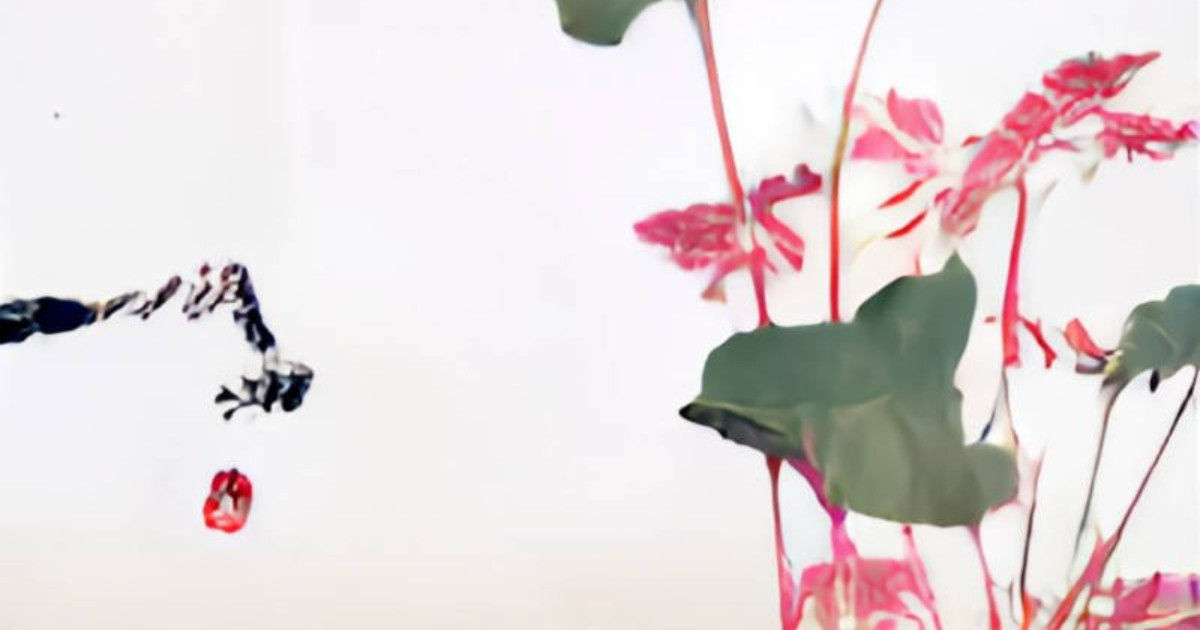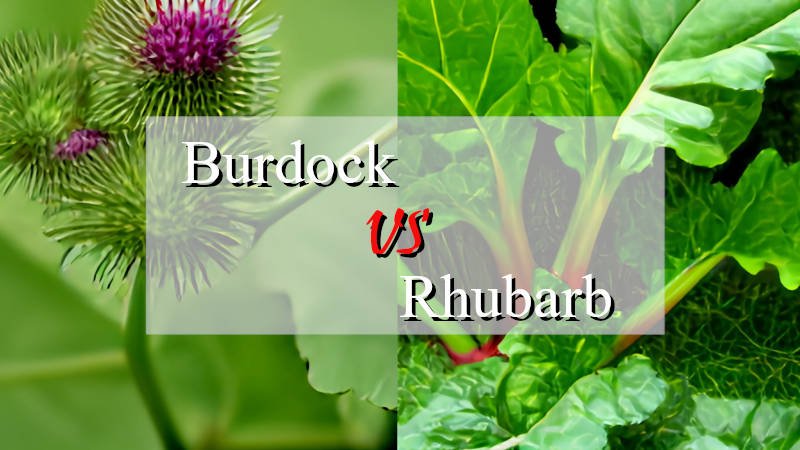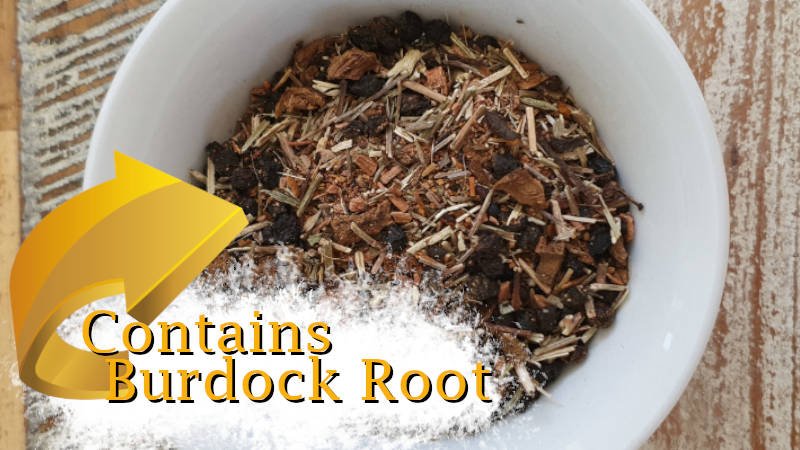As we look more closely at the burdock vs rhubarb discussion some key considerations need to be made. These have more to do with the rhubarb side of the discussion. A wrong choice here can be more than problematic.
But what about the other side of the coin, is burdock poisonous? Generally, burdock is considered safe to consume. But that’s not all that there is to that conversation either. We’ll look more closely at key things you’ll need to know here too.
Table of Contents
The History of Burdock vs Rhubarb
To get a better idea of the role that burdock vs rhubarb has played in human history, we are going to have to go back in time a little bit.
Rhubarb has been used for medicinal and culinary purposes for thousands of years. The earliest recorded use of rhubarb can be traced back to ancient China, where it was used as a medicinal herb in traditional Chinese medicine (TCM) as early as 270 BCE. 1
The Chinese used the root and stem of the plant (Rheum palmatum), which is called Da Huang, to treat a variety of ailments, including constipation, diarrhea, and fever. The root was also used as a laxative, and to treat respiratory problems, skin diseases, and jaundice. 2
Rhubarb has also been used for similar purposes by ancient Egyptians. Rhubarb was also used in Greece and Rome as a laxative, and in the medieval Arabic world, it was used as a treatment for jaundice. 3 4 5
In Europe, rhubarb didn’t become a common food until the 18th century. It was used to make pies and jams. The first cookbook that mentions rhubarb as an ingredient is believed to be “The Art of Cookery Made Plain and Easy” by Hannah Glasse in 1747. 6
It’s only in the more recent 19th century that rhubarb has become a more widely used plant, this may be because it was often too expensive, and was more frequently used as a medicinal plant. As it became more affordable, its popularity grew and it is now a common ingredient in culinary dishes in many parts of the world.
On the other hand, burdock (Arctium spp.) has been used for medicinal and culinary purposes for centuries, though the earliest records of its use are not as well-documented as those for rhubarb.
In TCM, burdock has been used for over a thousand years to treat various conditions such as skin conditions, respiratory infections, and digestive complaints. 7

In Europe, burdock has been known for medicinal use since the Middle Ages. Culpeper’s Complete Herbal, a popular herbal guide published in England in 1653, recommends burdock as a treatment for a wide range of ailments, including boils, wounds, and gout. 8
Burdock root was introduced in Japan in the 9th century as a vegetable, and it’s been used in Japanese and Korean cuisine since then. It’s known as “gobo” and “u-eong” respectively. 9
Burdock root has a long history of being used as a food and medicine in many cultures, and its use likely predates many written records.
Burdock root is also considered a nutritious food source and it is high in fibre, vitamins, and minerals. The root is peeled or scraped before being cooked and is often used in soups and stews or sautéed as a side dish.
3 Critical Rhubarb Considerations
As we take a closer look at the rhubarb-specific side of the burdock vs rhubarb topic, it is worth noting that the majority of interest is around wild rhubarb and common rhubarb. For good measure, we will also take a look at false rhubarb.
Common Rhubarb
Common or garden rhubarb is from the buckwheat family and has in more modern times been cultivated as a crop plant.
Two main botanical species of rhubarb originated out of Europe, Rheum rhabarbarum and Rheum rhaponticum. It is understood that around the 1800s a targeted effort to propagate using open-pollinated seed resulted in a hybridised form of the plant which then became the dominant species for farming purposes.
It is important to note that the first season of stalks is often too high in oxalic acid to be considered safe to consume. This is the same for the leaves of the rhubarb plant regardless of the number of seasons the plant has been growing.
Oxalic acid is an ingredient in cleaning products that are designed to remove rust stains and other stains from concrete and sidewalks, swimming pools, boat timbers, machinery, and more. 10
Wild Rhubarb
Next up on the burdock vs rhubarb discussion is wild rhubarb (Rheum palmatum). This also known as Chinese rhubarb or Turkey rhubarb, is a species of rhubarb that is native to China and Central Asia. It is a perennial plant that grows up to 3 m tall. The leaves are large and glossy, and the stalks are green or red. It has similar culinary uses as the common rhubarb with a tart flavour.
The root of wild rhubarb has been used in traditional Chinese medicine for centuries, it is believed to have laxative and detoxifying properties, and it is also to be a remedy for various ailments such as diarrhea, indigestion, and fever. 11
Wild rhubarb is not as common in cultivation as the common garden rhubarb, but it can be grown in temperate climates with well-drained soil, and it requires similar growing conditions as the common rhubarb.
It is important to note that r*hubarb leaves contain high levels of oxalic acid, which can be harmful if consumed in large amounts, for this reason only the stalks should be consumed. 12
Several species of plants are native to North America and are commonly referred to as “wild rhubarb.” These include:
- Rumex crispus
- This is a species of wild rhubarb that is native to Europe and it’s also known as curled dock, yellow dock, and narrow-leaved dock. It’s an invasive weed that has been introduced to many parts of the world, including North America. 13
- Rumex orbiculatus
- Also known as broad-leaved dock, native to North America it’s found in damp soils, meadows, and along stream banks. 14
- Rumex verticillatus
- It is also known as common dock or whorled dock and is native to North America. it’s found in damp soils, meadows, and along stream banks. 15
As touched upon earlier, it is important to note that all parts of these plants, except for the stalks which are edible when cooked, are high in oxalic acid and should not be consumed in large amounts.
It is also worth noting that many species of wild rhubarb and other plants that are commonly referred to as wild rhubarb are considered invasive species, and various parks and wildlife departments advise that they not be deliberately planted or spread.
False Rhubarb
When looking at false rhubarb vs rhubarb you’ll be considering how to spot what is inedible rhubarb.
False rhubarb, also known as “rhubarb impostor” or “fake rhubarb,” is a common name for a variety of plants that resemble common rhubarb, but are not closely related to it. Some of the plants that are commonly referred to as false rhubarb include:
- Buckwheat (Fagopyrum esculentum)
- This plant is a common food crop in Asia and is often used to make flour and porridge. Its leaves are similar in shape to those of rhubarb, but are more triangular and have a distinct white midrib. 16
- Chinese lantern (Physalis alkekengi)
- This is a species of groundcherry that has attractive orange and red lantern-like calyx. 17
- Daylilies (Hemerocallis spp.)
- Some varieties of daylilies have leaves that are similar in shape to those of rhubarb, but they lack the characteristic red stalks. 18
- Knotweed (Polygonum spp.)
- This is an invasive weed commonly found in the east part of the US and Asia. Some species of knotweed have leaves that resemble those of rhubarb, but they do not produce edible stalks. 19
Poisonous Burdock Lookalikes
Considering the burdock vs rhubarb pitfalls, there are several burdock poisonous look-alike plants that you should be aware of. The importance of knowing about these is key when considering foraging for these plants in the wild.
Many sources advise against foraging for foods as the risks associated with misidentification are so high. The reason this content has been provided is to underline the importance of knowing what you are consuming.
As a result, relying on trusted sources, like HerbiTea and their Iron Fluorine tea blend which contains burdock, becomes something worth considering more closely.
Some of the poisonous burdock lookalikes are considered in a previous article where we considered the question ‘Is burdock root good for you?’ specifically looking at which burdock you can eat.
FAQs
Can You Eat Burdock?
Yes. Burdock is considered to be generally edible. The leaves and stems are more often avoided as they can be unpalatable. The main part of the burdock plant that is consumed is the root. This is typically best harvested in the first year of the plant’s growth after it has gone to seed.
Is Common Burdock Poisonous?
Common burdock (Arctium minus) is not considered to be poisonous. While the plant is not typically consumed as a food source, the roots and leaves of the plant can be consumed in small amounts without causing significant harm.
However, if consumed in large quantities, burdock may cause some gastrointestinal distress such as stomach pain, vomiting, and diarrhea. It is always a good idea to consult a qualified professional before consuming any wild plants, as many plants can have toxic look-alikes.
Is Burdock in the Rhubarb Family?
No, burdock is not in the rhubarb family. Burdock is a member of the Asteraceae family, which is also known as the daisy or sunflower family. Some common plants in this family include sunflowers, chrysanthemums, and daisies.
While rhubarb is in the Polygonaceae family, which also includes plants such as dock, sorrel, and knotweed. These two families have very different characteristics.
Conclusion
Closing out the burdock vs rhubarb discussion, it is abundantly clear that there are edible versions of both plants. Some parts of the plant are considered to be at the least unpalatable, or straight-up toxic at the other end of the scale.
If you are planning on foraging for either of these, please make sure you have the support of someone with suitable proven expertise as this is too risky to make a simple mistake with.
References
- “What we already know about rhubarb: a comprehensive review” – H. Xiang, J. Zuo, F. Guo, D. Dong, 26 August 2020 [BCM] [Archive] ↩︎
- “Rhubarb (Da Huang ) Rheum Palmatum and its Many Uses in Traditional Chinese Medicine” – W. Maclean, P. Townsend, Last Checked 11 January 2023 [Acupuncture.com] [Archive] ↩︎
- “The Roots of Rhubarb” – C. M. Foust, 1992 [De Gruyter] [Archive] ↩︎
- “Botanical Sources of Early Medicines” – W. S. Keezer, December 1963 [JStor] [Archive] ↩︎
- “History of Slimming Diets up to the Late 1950s” – I. Zarzo, P. M. Boselli, J. M. Soriano, 24 March 2022 [MDPI] [Archive] ↩︎
- “The Art Of Cookery” – H. Glasse, 1747 [WayBack] ↩︎
- “Effect of Rhubarb on Gastrointestinal Dysfunction in Critically Ill Patients: A Retrospective Study Based on Propensity Score Matching” – X. Zhang, L. Wang, D. C. Chen, 20 May 2018 [PubMed] [Archive] ↩︎
- “Culpeper’s Complete Herbal” – N. Culpeper, 1654 [WayBack] ↩︎
- “History of Amazake and Rice Milk (1000 BCE to 1021)” – W. Shurtleff, A. Aoyagi, 2021 [Google Books] [Archive] ↩︎
- “Cleaning with Oxalic Acid? Here’s What you Need to Know.” – CoreChem Staff, 30 July 2021 [CoreChem] [Archive] ↩︎
- “Rhubarb Purported Benefits, Side Effects & More” – MSK Staff, 8 November 2022 [MSK] [Archive] ↩︎
- “What is oxalic acid (oxalate), and is it dangerous?” – J. Meacham, Z. Sherrell, 20 July 2022 [Medical News Today] [Archive] ↩︎
- “Rumex crispus” – National Herbarium of NSW, K. L. Wilson, May 2018 [PlantNET] [Archive] ↩︎
- “Rumex orbiculatus” – TWC Staff, 7 May 2012 [Lady Bird Johnson Wildflower Center] [Archive] ↩︎
- “Rumex verticillatus – swamp dock” – National Science Foundation Staff, Last Checked 11 January 2023 [Native Plant Trust] [Archive] ↩︎
- “Fagopyrum esculentum – Moench.” – R. McTaggart, 23 June 2007 [PFAF] [Archive] ↩︎
- “Physalis alkekengi” – Flora SA Staff, Last Checked 11 January 2023 [Flora SA] [Archive] ↩︎
- “Daylily Hemerocallis spp.” – Candide Staff, Last Checked 11 January 2023 [Candide] [Archive] ↩︎
- “Polygonum spp.” – Candide Staff, Last Checked 11 January 2023 [Candide] [Archive] ↩︎
Last Updated on 5 months by D&C Editorial Team



